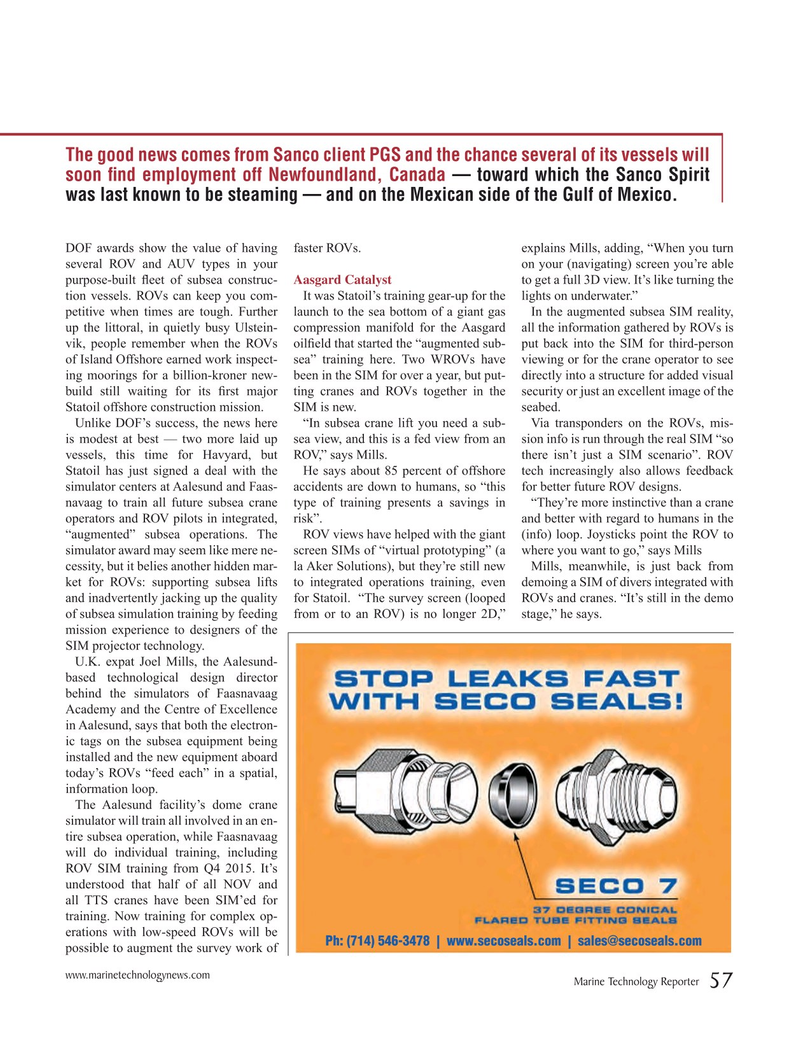
Page 57: of Marine Technology Magazine (October 2015)
AUV Operations
Read this page in Pdf, Flash or Html5 edition of October 2015 Marine Technology Magazine
The good news comes from Sanco client PGS and the chance several of its vessels will soon ? nd employment off Newfoundland, Canada — toward which the Sanco Spirit was last known to be steaming — and on the Mexican side of the Gulf of Mexico.
DOF awards show the value of having faster ROVs. explains Mills, adding, “When you turn several ROV and AUV types in your on your (navigating) screen you’re able purpose-built ? eet of subsea construc- Aasgard Catalyst to get a full 3D view. It’s like turning the tion vessels. ROVs can keep you com- It was Statoil’s training gear-up for the lights on underwater.” petitive when times are tough. Further launch to the sea bottom of a giant gas In the augmented subsea SIM reality, up the littoral, in quietly busy Ulstein- compression manifold for the Aasgard all the information gathered by ROVs is vik, people remember when the ROVs oil? eld that started the “augmented sub- put back into the SIM for third-person of Island Offshore earned work inspect- sea” training here. Two WROVs have viewing or for the crane operator to see ing moorings for a billion-kroner new- been in the SIM for over a year, but put- directly into a structure for added visual build still waiting for its ? rst major ting cranes and ROVs together in the security or just an excellent image of the
Statoil offshore construction mission. SIM is new. seabed.
Unlike DOF’s success, the news here “In subsea crane lift you need a sub- Via transponders on the ROVs, mis- is modest at best — two more laid up sea view, and this is a fed view from an sion info is run through the real SIM “so vessels, this time for Havyard, but ROV,” says Mills. there isn’t just a SIM scenario”. ROV
Statoil has just signed a deal with the He says about 85 percent of offshore tech increasingly also allows feedback simulator centers at Aalesund and Faas- accidents are down to humans, so “this for better future ROV designs. navaag to train all future subsea crane type of training presents a savings in “They’re more instinctive than a crane operators and ROV pilots in integrated, risk”. and better with regard to humans in the “augmented” subsea operations. The ROV views have helped with the giant (info) loop. Joysticks point the ROV to simulator award may seem like mere ne- screen SIMs of “virtual prototyping” (a where you want to go,” says Mills cessity, but it belies another hidden mar- la Aker Solutions), but they’re still new Mills, meanwhile, is just back from ket for ROVs: supporting subsea lifts to integrated operations training, even demoing a SIM of divers integrated with and inadvertently jacking up the quality for Statoil. “The survey screen (looped ROVs and cranes. “It’s still in the demo of subsea simulation training by feeding from or to an ROV) is no longer 2D,” stage,” he says.
mission experience to designers of the
SIM projector technology.
U.K. expat Joel Mills, the Aalesund- based technological design director behind the simulators of Faasnavaag
Academy and the Centre of Excellence in Aalesund, says that both the electron- ic tags on the subsea equipment being installed and the new equipment aboard today’s ROVs “feed each” in a spatial, information loop.
The Aalesund facility’s dome crane simulator will train all involved in an en- tire subsea operation, while Faasnavaag will do individual training, including
ROV SIM training from Q4 2015. It’s understood that half of all NOV and all TTS cranes have been SIM’ed for training. Now training for complex op- erations with low-speed ROVs will be
Ph: (714) 546-3478 | www.secoseals.com | [email protected] possible to augment the survey work of www.marinetechnologynews.com
Marine Technology Reporter 57
MTR #8 (50-64).indd 57 9/29/2015 3:24:40 PM

 56
56

 58
58
